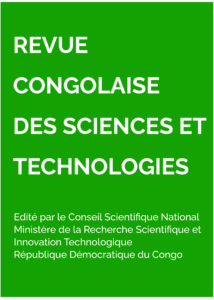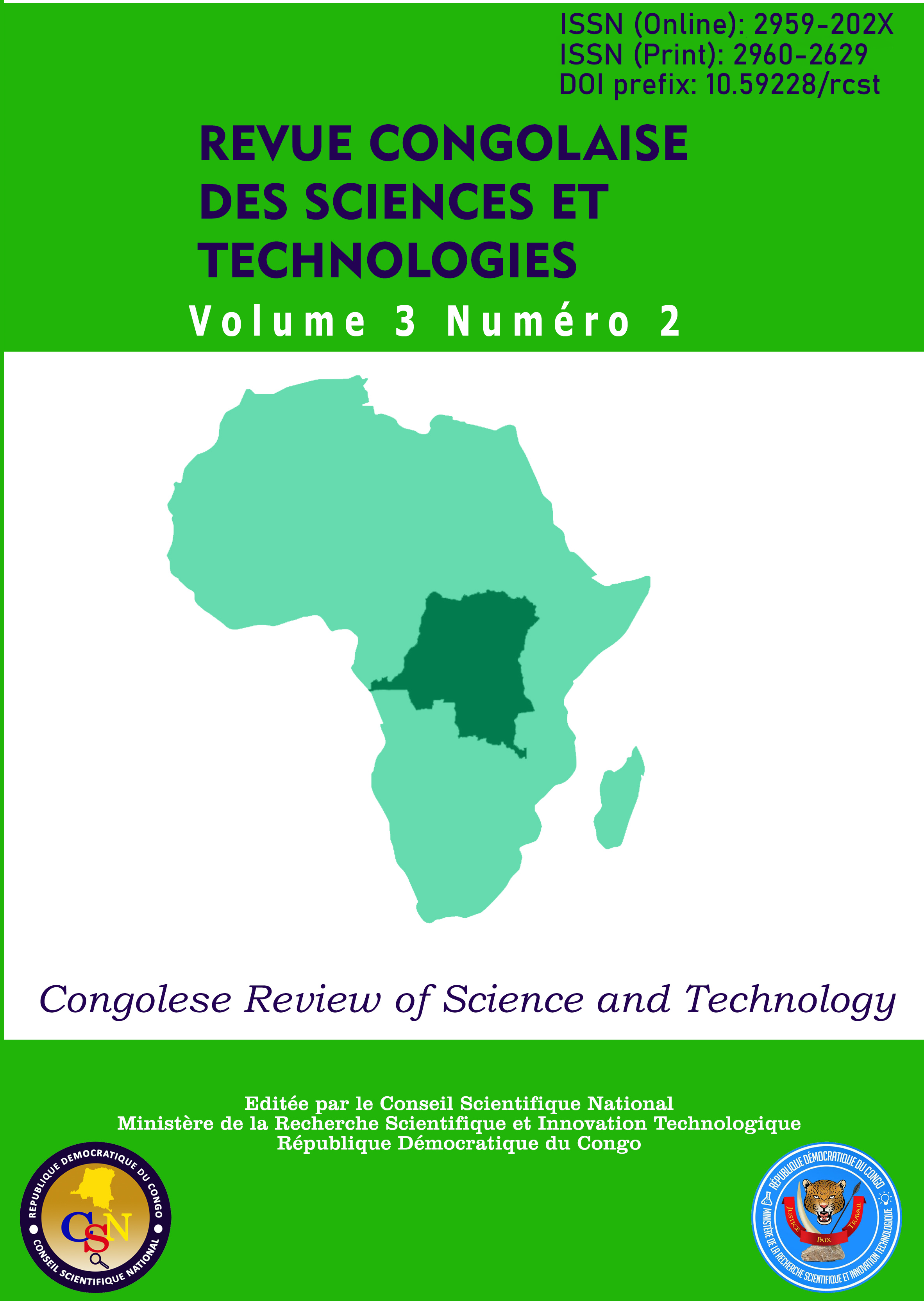Evaluation in silico du profil toxicologique de quelques molécules isolées de Aloe vera et de la pastèque (Citrullus lanatus) utilisées dans la formulation des crèmes solaires
Contenu principal de l'article
Résumé
La pharmacocinétique et la toxicologie cutanées sont importantes en cosmétologie, car les effets nocifs de la lumière
ultraviolette nécessitent une photoprotection externe, comme les crèmes solaires contenant des filtres solaires. Cependant,
certains de ces composés présentent une toxicité pouvant nuire à la peau. Ainsi, les produits à base de plantes naturelles sont
de plus en plus étudiés pour leur faible toxicité. Cette étude a utilisé des outils bio-informatiques pour évaluer la toxicité de
six molécules, dont trois issues de l'Aloe vera et trois de la pastèque. Toutes les molécules à l'exception du lycopène ont un
bon profil toxicologique. Les approches computationnelles sont présentées comme des outils rapides et peu coûteux pour
effectuer des prédictions et servir de base aux futures études expérimentales.
Details de l'article

Ce travail est disponible sous licence Creative Commons Attribution - Pas d’Utilisation Commerciale - Partage dans les Mêmes Conditions 4.0 International.
Références
Ahmed, H.M & Nasr Eldin, M.S. (2023). Aloe Vera
for Protects Skin Tissues from The Damaging
Impacts of Ultraviolet Radiation. International
Journal of Advanced Medical Sciences and
Technology (IJAMST), 3(4), 7-11.
Anitha, T. (2012). Medicinal Plants used in Skin
protection. Asian Journal of Pharmaceutical,
Clinical Research, 5(3), 35-38.
Apalla, Z., Nashan, D., Weller, R.B. (2017). Skin
Cancer: Epidemiology, Disease Burden,
Pathophysiology, Diagnosis, and Therapeutic
Approaches. Dermatol. Ther, 7, 5–19.
Cerqueira, N.M., Gesto, D., Oliveira, E.F., SantosMartins, D., Bras, N.F., Sousa, S.F. (2015)
Receptor-based virtual screening protocol for
drug discovery. Arch. Biochem. Biophys, 582,
–67.
Daina, A., Olivier, M., Zoete, V. (2017).
SwissADME: a free web tool to evaluate
pharmacokinetics. druglikeness and medicinal
chemistry friendliness of small molecules.
Scientific Reports, 7, 42717.
Downs, C.A., DiNardo, J.C., Alice, D.S., Rodrigues
M.S., Lebaron, P. (2021). Benzophenone
Accumulates over Time from the Degradation
of Octocrylene in Commercial Sunscreen
Products. Chem. Res. Toxicol, 34(4), 1046–
D’Orazio, J., Jarrett, S., Amaro-Ortiz, A., Scott, T.
(2013). UV Radiation and the Skin.
International Journal of Molecular Science, 14,
–12248.
Gleeson, M.P. (2008). Generation of a set of simple,
interpretable ADMET rules of thumb. Journal
of Medicinal Chemistry, 51(4), 817–834.
Habrant, D. (2008). Synthèse et caractérisation de
nouveaux antioxydants, dérivés monoaromatiques d’acides pulviniques, pour des
applications en dermo-cosmétique [Thèse de
Doctorat, Institut Gilbert Laustriat, Université
Louis Pasteur].
Hughes, J.D., Blagg, J., Price, D.A., Bailey, S.,
DeCrescenzo, G.A., Devraj, R.V. (2008).
Physiochemical drug properties associated with
in vivo toxicological outcomes. Bioorg. Med.
Chem. Lett, 18(17), 4872–4875.
Kasende, O.E., Matondo, A., Muya, J.T., Scheiner, S.
(2017). Interactions between temozolomide and
guanine and its S and Se-substituted analogues.
International Journal of Quantum Chemistry,
(3), 157–169.
Lipinski, C.A. (2000). Drug-like properties and the
causes of poor solubility and poor permeability.
J. Pharmacol. Toxicological. Meth, 44(1), 235–
Ma, J., Wang, Z., Qin, C., Wang, T., Hu, X, Ling W.
(2023). Safety of benzophenone-type UV filters:
A mini review focusing on carcinogenicity,
reproductive and developmental toxicity.
Chemosphere, 326, 138455.
Matondo, A., Dendera, W., Isamura, B.K, Ngbolua,
K.N., Mambo, H.V.S., Muzomwe, M., Mudogo,
V. (2022). In silico Drug Repurposing of
Anticancer Drug 5-FU and Analogues Against
SARS-CoV-2 Main Protease: Molecular
Docking, Molecular Dynamics Simulation,
Pharmacokinetics and Chemical Reactivity
Studies. Advances and Application in
Bioinformatics and Chemistry, 15(2), 59–77.
Mbanga, L., Lenghomo, L., Ngoy, P., Lundemba,
A.S., Zuka, M., Ngbolua, K.N., Mpiana, P.T.
(2023). Antioxidant Properties of Some Plants
Extracts Used As Natural Sunscreen in the
Formulated Cream. Revue Congolaise des
Sciences et Technologie, 2(1), 185–190.
Medici, A., Luongo G., Di Fabio G., Zarrelli, A.
(2022). Environmental Fate of Organic
Sunscreens during Water Disinfection
Processes: The Formation of Degradation ByProducts and Their Toxicological Profiles.
Molecules, 27(14), 4467.
Mvondo, J.G.M., Matondo, A., Mawete, D.T.,
Bambi, S.M.N., Mbala, B.M., Lohohola, P.O.
(2021). In silico ADME/T properties of quinine
derivatives using SwissADME and pkCSM
webservers. International Journal of Tropical
Disease and health, 42(11), 1–12.
Ngbolua, K. N., Kilembe, J. T., Matondo, A.,
Ashande, C. M., Mukiza, J., Nzanzu, C. M.,
Ruphin, F. P., Baholy, R., Mpiana, P. T., &
Mudogo, V. (2022). In silico studies on the interaction of four cytotoxic compounds with
angiogenesis target protein HIF-1α and human
androgen receptor and their ADMET properties.
Bulletin of the National Research Centre, 46(1),
-12.
Pires, D.E., Blundell, T.L., Ascher, D.B. (2015).
pkCSM: Predicting small-molecule
pharmacokinetic and toxicity properties using
Graph-Based Signatures. Journal of Medicinal
Chemistry, 58(9), 4066–4072.
Ramos, S., Homem, V., Alves, A., et al. (2016). A
review of organic UV-filters in wastewater
treatment plants. Environ. Int, 86, 24-44.
Waring, M.J., Arrowsmith, J., Leach, A.R., Leeson,
P.D., Mandrell, S., Owen, R.M. et al. (2015).
An analysis of the attrition of drug candidates
from four major pharmaceutical companies.
Nat. Rev. Drug Discov, 14(7), 475–486.
Xiong, G., Wu, Z., Yi, J., Fu, L., Yang, Z., Hsieh, C.
et al. (2021). ADMETlab 2.0: An integrated
online platform for accurate and comprehensive
predictions of ADMET properties. Nucleic
Acids Research, 49, W5-W14 (Web Server
Issue).

